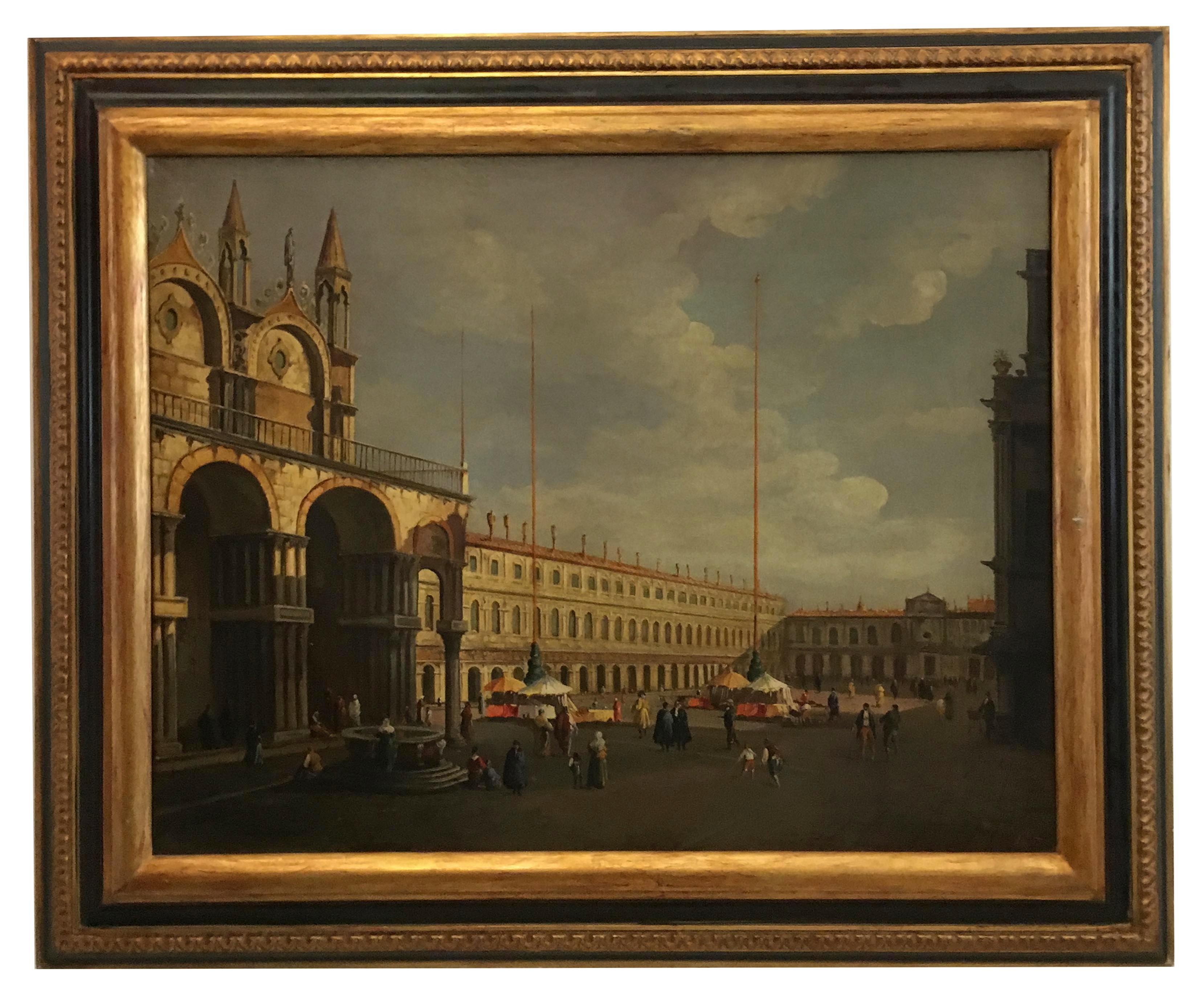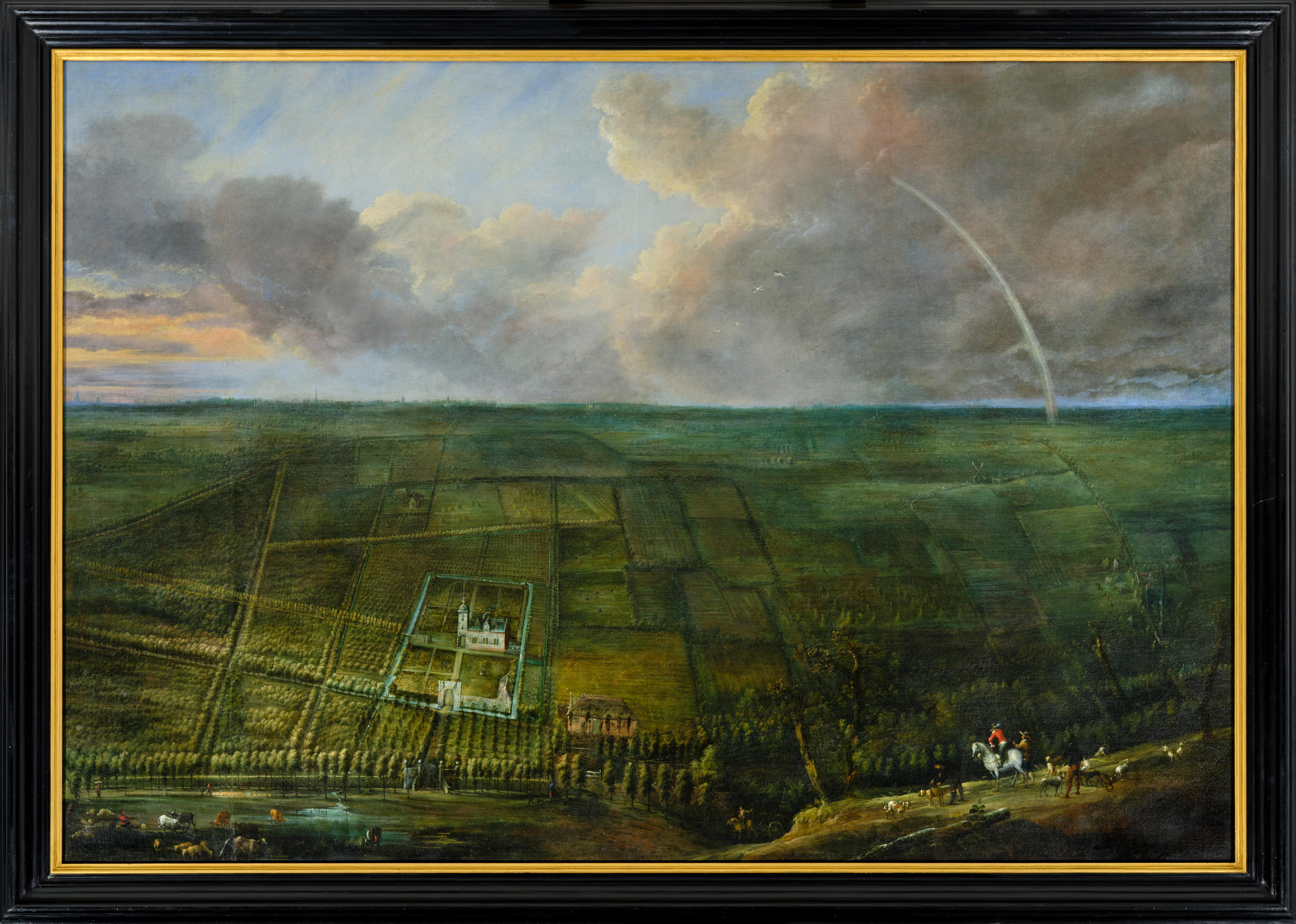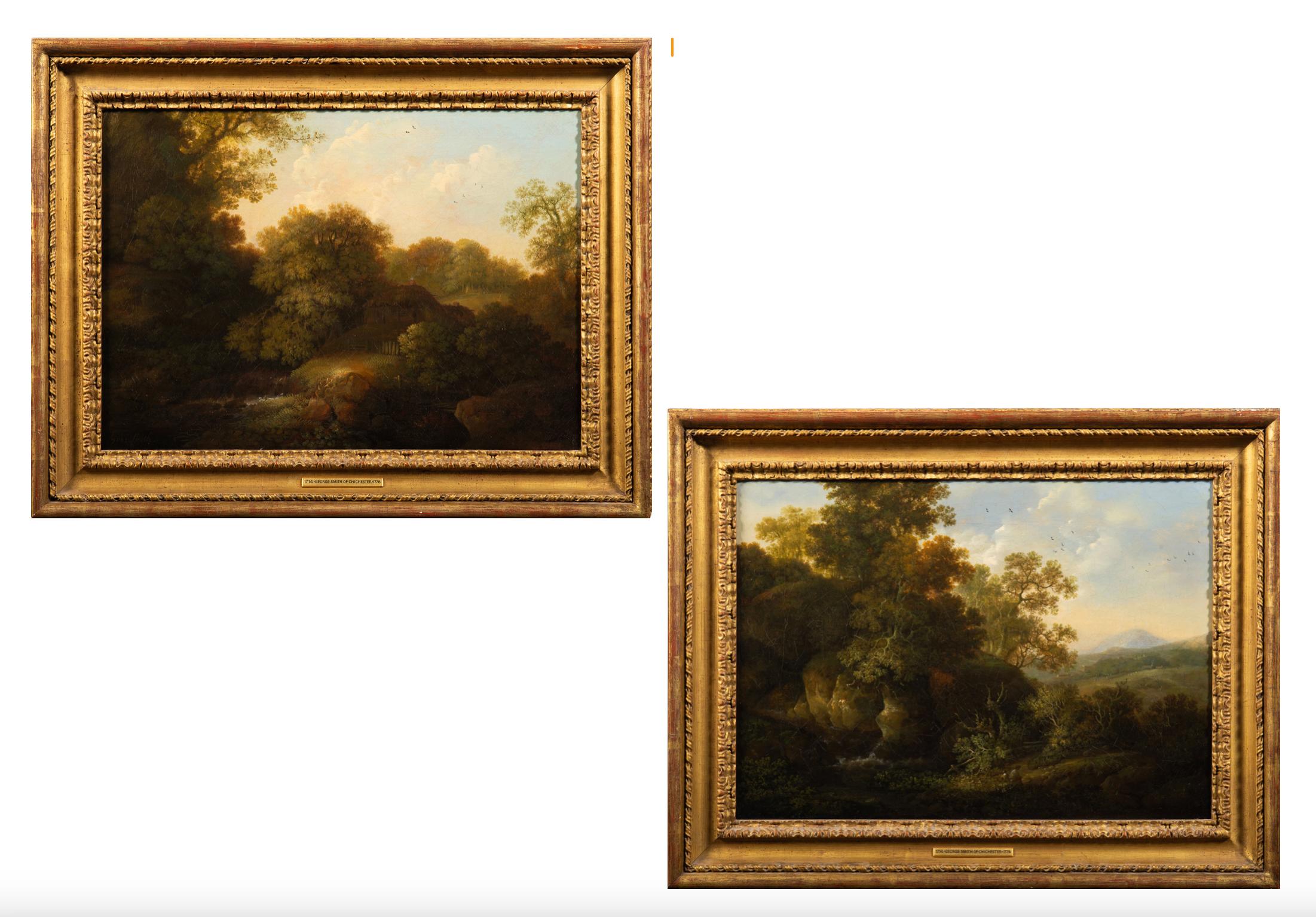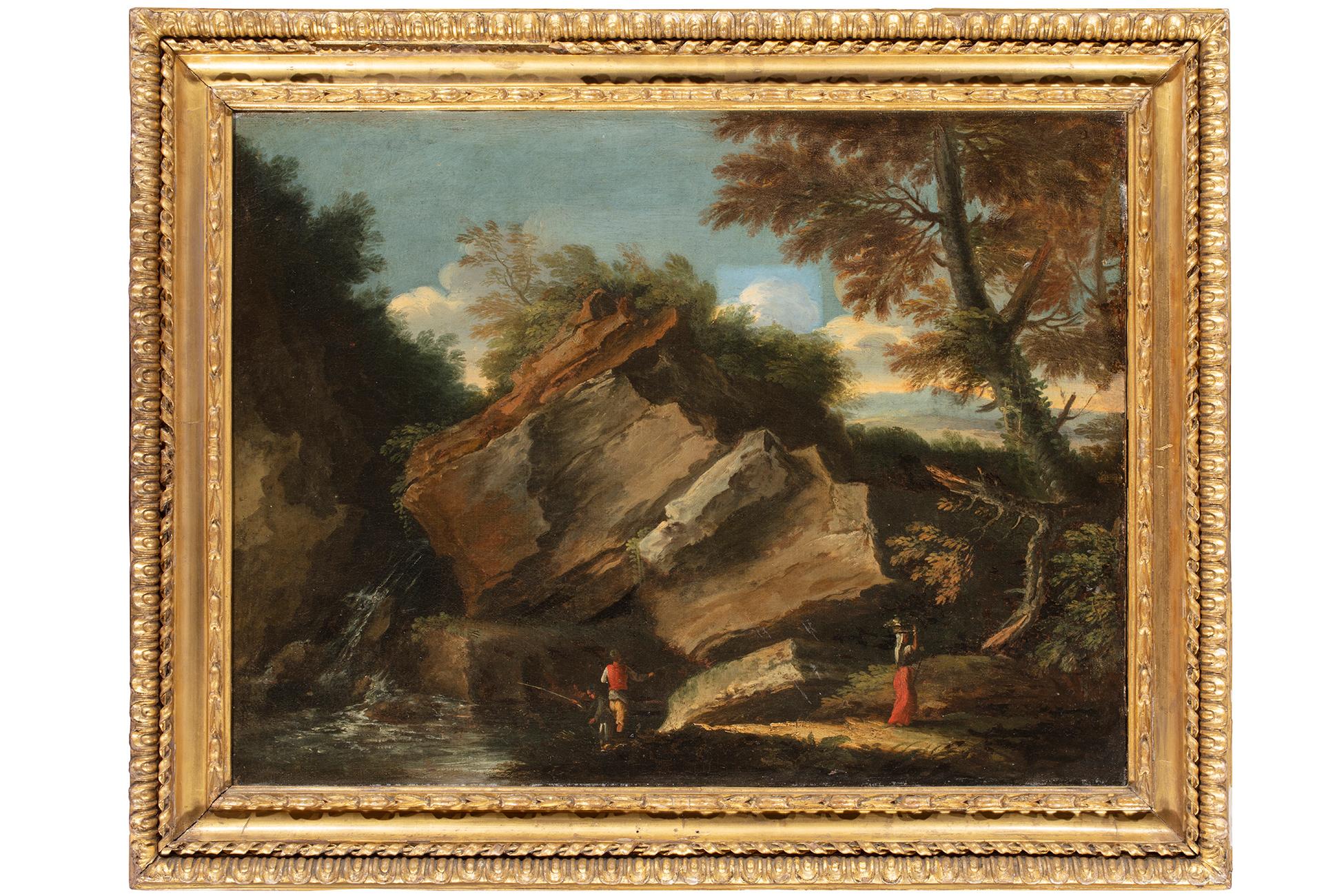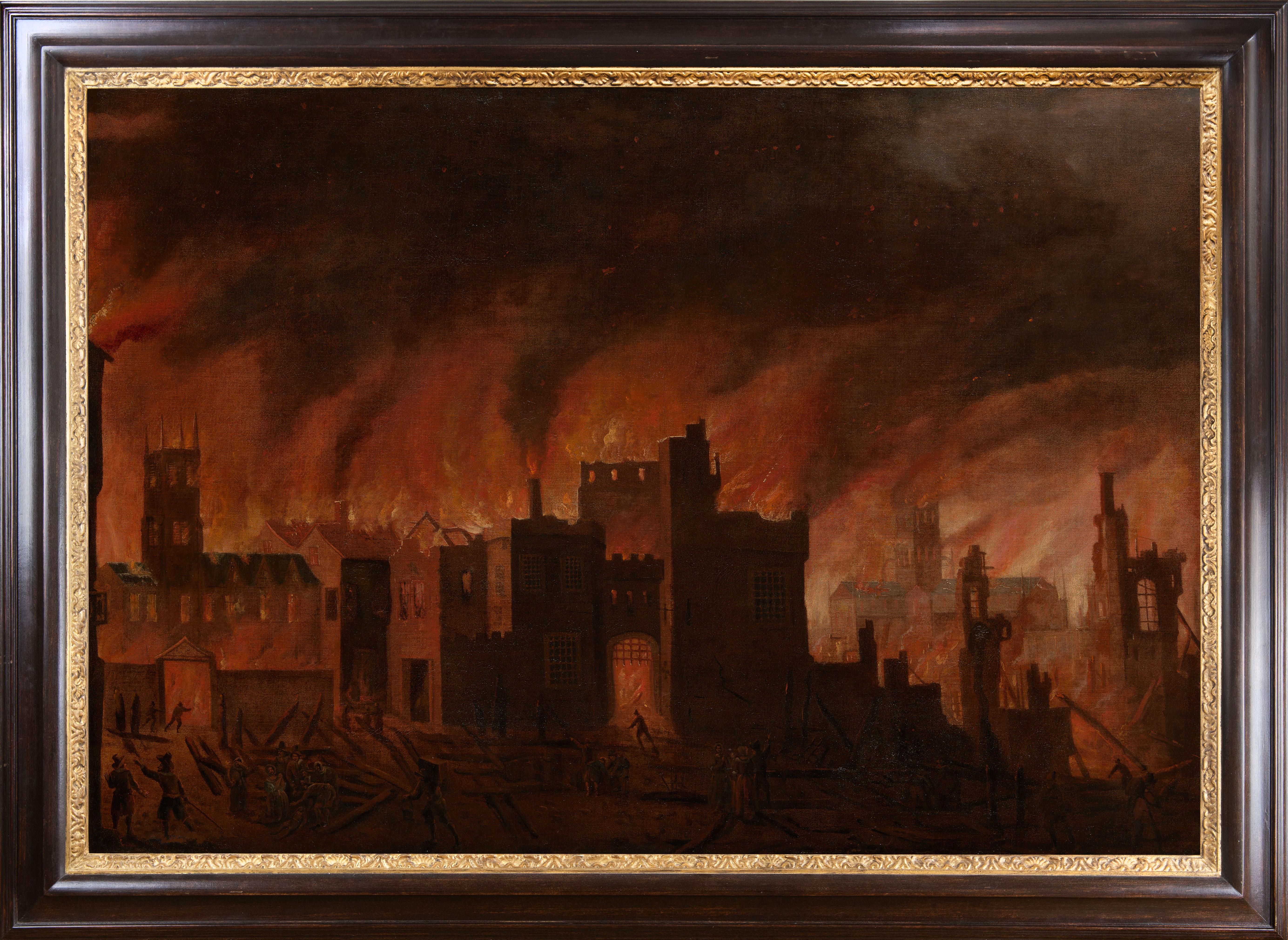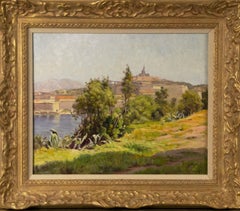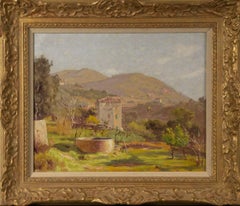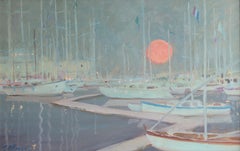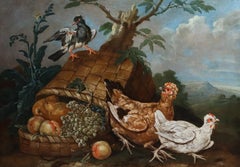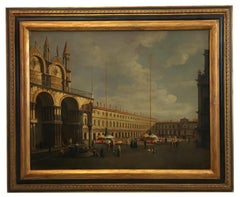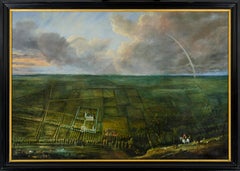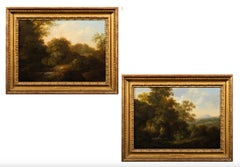Items Similar to A Pair of Venetian Canal Scenes- San Giorgio Maggiore & Santa Maria Della Salute
Want more images or videos?
Request additional images or videos from the seller
1 of 16
A Pair of Venetian Canal Scenes- San Giorgio Maggiore & Santa Maria Della SaluteCirca 1790
Circa 1790
About the Item
Circle of Francesco Guardi (1712-1793)
Venetian Canal Scenes, a pair
-San Giorgio Maggiore from the Bacino di San Marco
-Santa Maria della Salute from the Grand Canal
Oils on canvas: 13 X 18 ¼ in. Frame: 18 ½ x 23 ½ in. Late 18th century.
Francesco Guardi was an Italian painter of veduta, nobleman, and a member of the Venetian School.
He was born in Venice in 1712, the son of a minor painter, Domenico Guardi, and went on to become, after Canaletto, the main painter of views of Venice in the mid-18th century.
His early figurative paintings were carried out in association with his brother, Gian Antonio, but in about 1760 Guardi turned to view painting, recording both the architecture of the city and the celebrations of its inhabitants in interior and exterior scenes. These works brought him great success. The earliest of these show the influence of Canaletto, but he gradually adopted a looser style characterized by spirited brush-strokes and freely imagined architecture.
This fabulous pair of Venetian scenes were painted by a talented but unidentified artist painting in the late 18th century.
Relined on a new support canvas by our gallery and professionally restored and re-varnished.
The paintings are unsigned
- Creation Year:Circa 1790
- Dimensions:Height: 19 in (48.26 cm)Width: 24 in (60.96 cm)
- Medium:
- Movement & Style:
- Circle Of:Francesco Guardi (1712 - 1792, Italian)
- Period:
- Condition:
- Gallery Location:West Sussex, GB
- Reference Number:1stDibs: LU1525215697772
About the Seller
4.8
Gold Seller
Premium sellers maintaining a 4.3+ rating and 24-hour response times
Established in 2002
1stDibs seller since 2021
42 sales on 1stDibs
Typical response time: 4 hours
- ShippingRetrieving quote...Shipping from: West Sussex, United Kingdom
- Return Policy
Authenticity Guarantee
In the unlikely event there’s an issue with an item’s authenticity, contact us within 1 year for a full refund. DetailsMoney-Back Guarantee
If your item is not as described, is damaged in transit, or does not arrive, contact us within 7 days for a full refund. Details24-Hour Cancellation
You have a 24-hour grace period in which to reconsider your purchase, with no questions asked.Vetted Professional Sellers
Our world-class sellers must adhere to strict standards for service and quality, maintaining the integrity of our listings.Price-Match Guarantee
If you find that a seller listed the same item for a lower price elsewhere, we’ll match it.Trusted Global Delivery
Our best-in-class carrier network provides specialized shipping options worldwide, including custom delivery.More From This Seller
View AllA View in Villefranche , South of France
By René Charles Edmond His
Located in West Sussex, GB
Rene Charles Edmond His
(1877 – 1960) French
'A Church on a Hill' A View of Villefranche, South of France
Oils on canvas: 13x16 in. (Frame: 20x2...
Category
Early 20th Century French School Landscape Paintings
Materials
Oil
Mountain Landscape, Col de Villefranche, South of France
By René Charles Edmond His
Located in West Sussex, GB
Rene Charles Edmond His
(1877 – 1960) French
Col de Villefranche, South of France
Oil on canvas: 13x16 in. (Frame: 20x23in.) Signed& inscribed ...
Category
Early 20th Century French School Landscape Paintings
Materials
Oil
'Twilight'
Located in West Sussex, GB
"Twilight"
Oil on artist's board, Signed in Cyrillic, and inscribed in Cyrillic in pencil verso, 15.5in x 24.25in. 21in x 30 in.
Igor Larionov is an impressionist artist, born in ...
Category
2010s Impressionist Landscape Paintings
Materials
Oil
Birds with an Upturned Basket of Fruit 2
Located in West Sussex, GB
Giovanni Agostino Cassana
(c.1658 – 6 May 1720) Venetian
Birds with an Upturned Basket of Fruit
Oil on canvas: 25 x 35 in. Frame: 33 x 43 in.
The canvas is unsigned
Abate, or Gio...
Category
1690s Renaissance Landscape Paintings
Materials
Oil
The River Arun, West Sussex
Located in West Sussex, GB
José Weiss
(1859-1919) British
Fishing on the River Arun
Oil on canvas.15x20 in. (frame:20x25 in.) Signed
Jose Weiss (Joseph Vincent Nicholas Francis We...
Category
Early 20th Century Impressionist Landscape Paintings
Materials
Oil
A Venetian Canal Scene
Located in West Sussex, GB
Yakov Besperstov
(1929-1989)
A Venetian Canal Scene
Oil on canvas: 13 x 18in. Frame: 18 x 23 in. Circa 1970’s
Yakov Tarasovich Besperstov was a So...
Category
20th Century Impressionist Landscape Paintings
Materials
Oil, Acrylic
You May Also Like
VENICE - In the Manner of Canaletto -Italian Landscape Oil on Canvas Painting
By Mario De Angeli
Located in Napoli, IT
Venice - Mario De Angeli - Italia 2006 - Oil on canvas cm. 70x90.
Mario De Angeli's canvas is an extraordinary work of Italian landscape painting. They are inspired by the landscap...
Category
Early 2000s Old Masters Landscape Paintings
Materials
Canvas, Oil
Panoramic View of an Estate on the edge of the Sonian Forest (near Brussels)
Located in PARIS, FR
This museum-sized painting takes us over an estate on the outskirts of the Sonian Forest near Brussels, temptingly identified as the Ter Coigne estate in Watermael (of which only some heavily modified buildings remain today).
This gigantic "bird's eye view" is certainly a workshop painting, executed around 1650 by several artists under the supervision of Lucas van Uden...
Category
1650s Old Masters Landscape Paintings
Materials
Linen, Oil
Announcing Angel Gabriel Maratta 17th Century Paint Oil on canvas Old master
Located in Riva del Garda, IT
The Announcing Angel Carlo Maratta (Camerano, 1625 – Rome, 1713)Workshop
Oil on canvas 63 x 75 cm. - Gilded wood frame 89 x 75 cm.
Excellent condition, restored, 19th century ...
Category
17th Century Old Masters Paintings
Materials
Oil
$9,132 Sale Price
20% Off
A pair of Classical landscapes
Located in Stoke, Hampshire
George Smith of Chichester (Chichester 1714-1776)
Landscape with figures resting by a river; River landscape with figures outside a thatched cottag...
Category
18th Century Old Masters Landscape Paintings
Materials
Oil
17th Century by Pietro Montanini Landscape Oil on Canvas
Located in Milano, Lombardia
PIETRO MONTANINI (Perugia, Italy, 1619 - 1689)
Title: Landscape
Medium: Oil on canvas
Dimensions: without frame 50 x 65 cm - with frame 64 x 79 cm
An...
Category
17th Century Old Masters Landscape Paintings
Materials
Canvas, Cotton Canvas, Oil
Early oil depicting the Great Fire of London
Located in London, GB
The Great Fire of London in September 1666 was one of the greatest disasters in the city’s history. The City, with its wooden houses crowded together in narrow streets, was a natural fire risk, and predictions that London would burn down became a shocking reality. The fire began in a bakery in Pudding Lane, an area near the Thames teeming with warehouses and shops full of flammable materials, such as timber, oil, coal, pitch and turpentine. Inevitably the fire spread rapidly from this area into the City. Our painting depicts the impact of the fire on those who were caught in it and creates a very dramatic impression of what the fire was like. Closer inspection reveals a scene of chaos and panic with people running out of the gates. It shows Cripplegate in the north of the City, with St Giles without Cripplegate to its left, in flames (on the site of the present day Barbican). The painting probably represents the fire on the night of Tuesday 4 September, when four-fifths of the City was burning at once, including St Paul's Cathedral. Old St Paul’s can be seen to the right of the canvas, the medieval church with its thick stone walls, was considered a place of safety, but the building was covered in wooden scaffolding as it was in the midst of being restored by the then little known architect, Christopher Wren and caught fire. Our painting seems to depict a specific moment on the Tuesday night when the lead on St Paul’s caught fire and, as the diarist John Evelyn described: ‘the stones of Paul’s flew like grenades, the melting lead running down the streets in a stream and the very pavements glowing with the firey redness, so as no horse, nor man, was able to tread on them.’
Although the loss of life was minimal, some accounts record only sixteen perished, the magnitude of the property loss was shocking – some four hundred and thirty acres, about eighty per cent of the City proper was destroyed, including over thirteen thousand houses, eighty-nine churches, and fifty-two Guild Halls. Thousands were homeless and financially ruined. The Great Fire, and the subsequent fire of 1676, which destroyed over six hundred houses south of the Thames, changed the appearance of London forever. The one constructive outcome of the Great Fire was that the plague, which had devastated the population of London since 1665, diminished greatly, due to the mass death of the plague-carrying rats in the blaze.
The fire was widely reported in eyewitness accounts, newspapers, letters and diaries. Samuel Pepys recorded climbing the steeple of Barking Church from which he viewed the destroyed City: ‘the saddest sight of desolation that I ever saw.’ There was an official enquiry into the causes of the fire, petitions to the King and Lord Mayor to rebuild, new legislation and building Acts. Naturally, the fire became a dramatic and extremely popular subject for painters and engravers. A group of works relatively closely related to the present picture have been traditionally ascribed to Jan Griffier...
Category
17th Century Old Masters Landscape Paintings
Materials
Oil, Canvas
